
Manufacturer's Specifications:
System Type: Three way, coherent phase.
Drivers: Three; 12-inch (300-mm) bass; 5-inch (110-mm) cone midrange, and 2-inch (50-mm) dome tweeter.
Nominal impedance: 8 ohms.
Frequency Response: 38 Hz to 22 kHz, ±2 dB.
Dimensions: 38 inches (96.5 cm) x 16.3 inches (40.6 cm) x 17.9 inches (45.5 cm).
Weight: 80 lbs. (36.3 kg).
Price: $1400.00.
The Model 105 Series II, hereafter referred to as 105.2, is an improved version of the very successful KEF Model 105. Extensive computer analysis, backed up by an equally extensive program of subjective listening, has led to this second-generation, top-of-the-line system from KEF Electronics Limited.
A three-way loudspeaker system, the drive units are positioned so as to retain the subjectively important time relationships of the original sound, and the enclosures are contoured to reduce sound field disturbances. The bass chamber has been extensively braced to eliminate residual resonances which were discovered by computer-assisted analysis, and the woofer itself is mechanically isolated from the enclosure by vibration isolators to reduce coloration in the lower midrange frequencies.
A 300-mm (12-inch) woofer covers the range from 38 Hz to 400 Hz. A 110-mm (5-inch) cone unit carries the frequencies from 400 Hz to 2500 Hz, while a 50-mm (2-inch) dome tweeter radiates frequencies above 2500 Hz. The crossover network is of extremely advanced design, providing not only correction for the acoustic amplitude and phase response of the drivers but the impedance presented to the power amplifier. In addition a particular response, fourth-order Linkwitz-Riley filter was chosen to keep the main acoustic lobe of the polar pattern coincident with the design axis of the loudspeaker at all frequencies. This necessitates computer matching of all driver units used in a stereo pair of systems.
The separate head assembly, which houses the midrange and tweeter units, can be rotated and tilted to position the optimum acoustic axis toward, the preferred listening position. A ±7 degree vertical tilt and ±30 degree horizontal rotation is provided by the housing assembly. A light-emitting diode (LED) can be energized by moderate level audio when a switch on the rear of the housing is set to "listening window" position. The glow is visible only within the optimum listening areas. This ingenious assembly allows rapid setup for the most uniform direct sound from the midrange and tweeter. Once adjusted for best listening position, the switch can then be used to convert the light to a peak level indicator, which glows when the peak-to-peak amplifier voltage exceeds that required to deliver its rated output power into 8 ohms. Peak level settings of 50, 60, 80, 100, 125, 150 and 200 watts adequately cover most amplifiers that might be used with this speaker.
Connection is made to well-marked terminals on the rear of the enclosure. An excellent set of installation instructions leads the user through a step-by-step procedure, and even the least technically oriented user should be able to set up the system for optimum sound quality.
Measurements
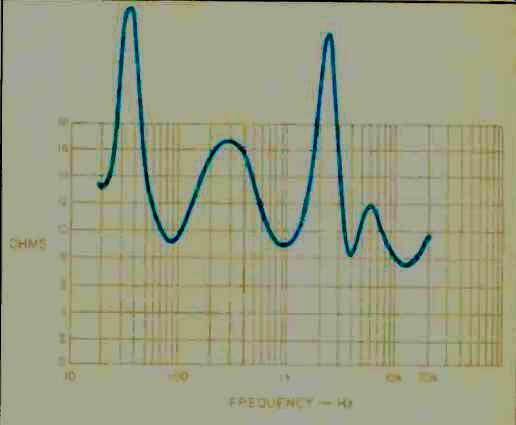
Fig. 1--Magnitude of impedance.
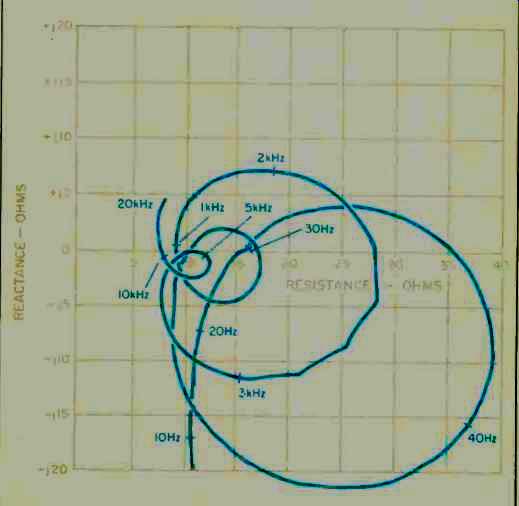
Fig. 2--Complex terminal Impedance.
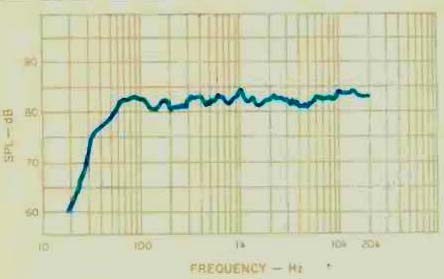
Fig. 3--Anechoic amplitude response at one meter with constant voltage
drive corresponding to one average watt into 8 ohms.
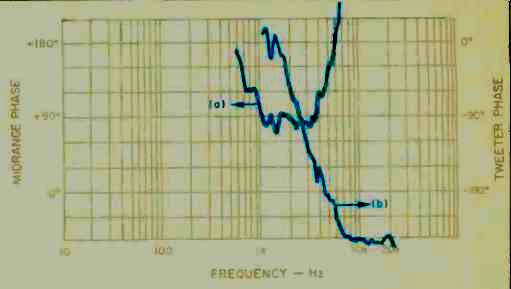
Fig. 4--Anechoic phase response at ore meter corrected for (a) the midrange's
air-path delay of 3.5103 mS and (b) the tweeter's air-path delay of 3.3057 mS.
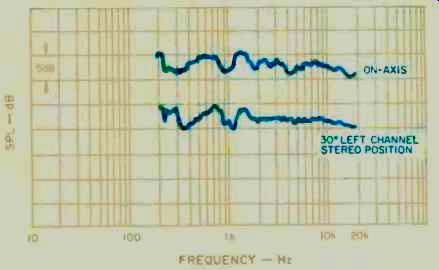
Fig. 5--Three-meter room response.
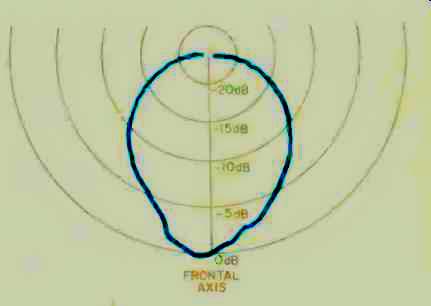
Fig. 6--Horizontal polar energy response.
The impedance at the terminals of the KEF 105.2 is plotted in Fig. 1, and the corresponding complex impedance, which includes the phase angle, is shown in Fig. 2. The lowest value of impedance through the audio band is 7.5 ohms and occurs at 12 kHz. Since this is a transition from capacitive to inductive reactance, the high-frequency impedance will present no amplifier loading problems. Even the worst-case loading, which occurs around 3.1 kHz with a 43 degree capacitive reactive angle, is high enough to present no difficulty. It is technically interesting to note that the KEF impedance rises below 20 Hz to approach the properties of a capacitor, and this is caused by a network within the electronic crossover. The system does not conduct current at zero frequency, so a d.c. offset in a power amplifier cannot pull the woofer cone away from the center of the driver's magnetic gap. This is a desirable feature because subsonic amplifier signals, excited by asymmetric music conditions, cannot cause woofer "breathing" that might create a peculiar form of cross-modulation distortion at robust sound levels.
The amplitude and phase parts of the frequency response are shown in Figs. 3 and 4 respectively. KEF is very specific in defining the listening geometry for the optimum direct sound response, using the built-in indicator light to define the optimum listening axis. These anechoic measurements, which correspond to the direct sound, were accordingly made with the measuring microphone bore-sighted with this indicator light. The amplitude response is, indeed, the most uniform in this position.
The arrival times do not precisely coincide for sound from the tweeter and midrange units, which are contained within the head assembly that mounts on the top of the woofer enclosure. The phase response, Fig. 4, shows that the time delay for the tweeter is 3.3057 milliseconds, and that of the midrange is 3.5103 milliseconds when the microphone is positioned one meter from the front of the KEF enclosure. The phase response transition, which indicates the apparent crossover frequency, occurs at around 5 kHz. The phase measurements are presented as two plots, one corrected for tweeter air-path delay and the other corrected for midrange air-path delay.
The three-meter room response is plotted in Fig. 5. The microphone is positioned in a conventional listening location three meters from the speaker and one meter above a carpeted floor. The KEF 105.2 was positioned 50 centimeters from a back wall, according to KEF recommendations, and the frequency spectrum of the first 13 milliseconds of sound to arrive at the measuring position is shown. Later sound arrivals, due to room reflections, are screened out of this measurement.
The direct sound is quite uniform over the full frequency range. Response variations below about 1500 Hz are principally due to reflections from the carpeted floor and amount to only ±2 dB. This measurement indicates that spectral balance of dynamic program material should be quite good. The uniformity of front position as well as stereo position (30 degrees off front axis with the high-frequency head pointed toward the measuring microphone) indicates a good stereo lateralization capability for the KEF 105.2.
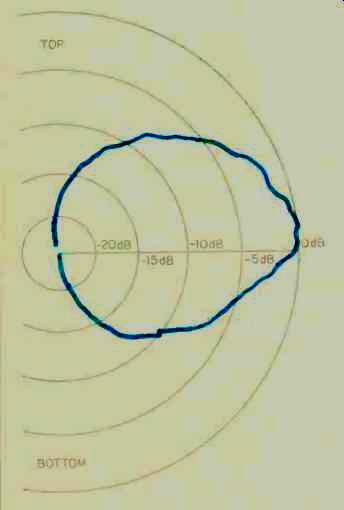
Fig. 7--Vertical polar energy response.
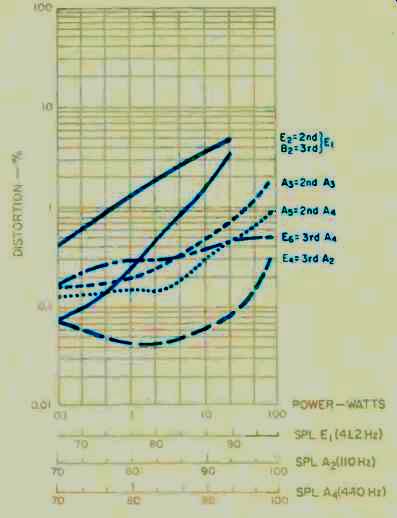
Fig. 8--Harmonic distortion for the musical tones of E1 or 41.2 Hz, A2 or
110 Hz, and A4 or 440 Hz.
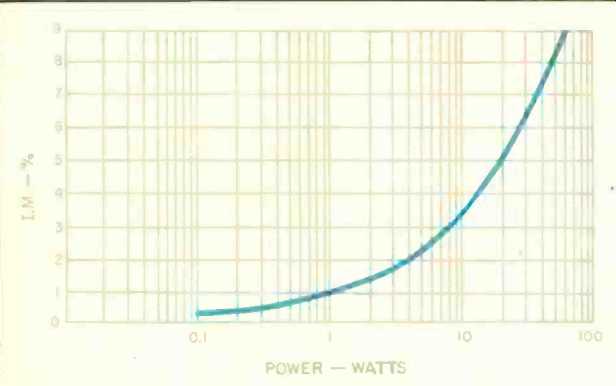
Fig. 9--IM distortion on 440 Hz produced by 41.2 Hz when mixed in one-to-one
proportion.

Fig. 10--Energy-time curve.
The horizontal and vertical polar response plots are shown in Figs. 6 and 7 respectively. What's shown is the total acoustic energy for direct sound over the frequency range from 20 Hz to 20 kHz as a function of azimuth (Fig. 6) and elevation (Fig. 7) relative to the front of the speaker.
Horizontal dispersion is sufficiently narrow at the-3 dB level (±16 degrees) that the high-frequency head must definitely be pointed toward the listening position for most accurate stereo imaging. The corresponding-3 dB vertical angles are 33 degrees elevation and 14 degrees depression from geometric center. This indicates that the KEF 105.2 should be positioned away from overhanging shelves and similar objects that could reflect sound toward the listening position.
Harmonic distortion for the music tones E1 (41.2 Hz), A2 (110 Hz) and A4 (440 Hz) is shown in Fig. 8. KEF protection circuitry cut off the E, test tone bursts at levels above 25 average watts, but did allow bursts of A2 and A4 up to 100 average watts (assuming constant voltage across 8 ohms). Harmonic distortion for the higher tones is quite low up to the maximum sound levels one could reasonably ask for home music reproduction; however, the low bass E distortion is a little higher than I would like to see in a loudspeaker system of this high a quality. The second harmonic level of E1 is 2 percent at 10 average watts and drops to 0.5 percent at 10 milliwatts.
Intermodulation of 440 Hz by 41 .2 Hz, when both are mixed in equal portion, is shown in Fig. 9. Up to 10 average watts, the IM is principally composed of amplitude modulation of 440 Hz by 41.2 Hz. At 10 average watts there is three percent peak-to peak amplitude modulation and 6 degrees peak-to-peak phase modulation of 440 Hz. This rises uniformly to 10 percent amplitude modulation and 12 degrees phase modulation at 100 average watts. This is quite a low level of IM distortion by loudspeaker standards.
For a linear speaker system, a one-decibel increase in drive voltage should produce a corresponding one-decibel increase in sound pressure level. If the change of sound pressure does not follow this pattern, then certain distortions may be created in stereo listening. For example, if this ratio of transfer drops with increasing drive power, then the resultant sound will be somewhat compressed in dynamics; loud passages will not be as loud as they should be, relative to soft passages. In the case of the KEF 105.2, the 440-Hz transfer ratio drops 0.5 dB at 10 average watts, compared with its level at 10 milliwatts. Middle C (262 Hz) transfer remains constant up to 100 average watts, and A2 (110 Hz) roughly follows the pattern of 440 Hz. This implies a small change in timbre for very loud passages compared with those same passages played at much softer level.
The crescendo test, which checks the masking influence of loud orchestral passages on a single inner tone, shows that the KEF 105.2 slightly softens such an inner voice. A tone of 440 Hz is reduced by approximately 0.7 dB when broad-band noise, at 20 dB higher level, is superimposed on the tone. This softening is essentially independent of level, even up to peak levels of 600 watts. This suggests a slight lateral and depth shift of solo instruments in the stereo illusion when broad-band peaks, such as due to brass, occur predominantly in one channel.
The energy-time response is shown in Fig. 10. This is the envelope of the impulse response, measured one meter in front of the enclosure. The first sound peak occurs at 3.3 milliseconds and is due to the tweeter. The first midrange sound blends quickly with the rapidly decaying tweeter sound to produce an elongated, but well-behaved, drop off of sound after 3.5 milliseconds. Small response irregularities beyond 3.5 milliseconds are due to residual reverberation and scatter from the tweeter/midrange housing. All in all, this is a good transient response and suggests excellent acoustic imaging.
Use and Listening Tests
Listening was performed before measurement, with the speakers positioned according to KEF recommendations. The backs of the enclosures were placed greater than 50 cm away from the back wall, with more than 2 meters distance from either speaker to its adjacent side wall. The speakers were separated by 3 meters, and listening was performed at a distance of 3 meters. No difficulty was encountered in determining the optimum listening window, and the LED indicator functioned well, not only as locator but as peak power indicator.
I tried to determine whether any audible distortion was produced if the LED indicators were left in the "listening window" function while listening to music. After all, the energy to activate the unit must come from the music signal and represents some small dynamic load for the power amplifier. I could not discern any audible distortion when the indicator was misused in this way, but to be safe, the proper music listening function should be selected, as KEF recommends.
My overall impression of tonal quality was of general smoothness throughout the frequency range. I sensed a slight mid-bass dominance and an extreme top end brightness which gave the impression of a slightly suppressed midrange. Piano music is reproduced accurately, one of the most difficult tests, and the KEF does not have the timbral problems in the octave of middle C which seem to plague many three-way speaker systems.
The KEF is substantially free of narrow-band resonances through the audible range. A very old and reliable way of checking system smoothness is to play older recorded material which is known to have ticks, scratches, and swishes. These aberrations are substantially suppressed on a smooth system, because the smooth system accurately reproduces the transients and does not add tonal coloration of its .own. I must admit to many hours of pleasurable listening to old but musically good recordings which were made enjoyable by the KEF. The KEF 105.2 scored extremely well on all types of program material. If I were forced to find fault, it would be with the extreme low bass response. On several of the extra wide range recordings I sensed that the extreme high frequencies were always there, but that the extreme low frequencies were deficient.
To check the bass, I hooked up a good quality subwoofer and after careful balance was able to restore the spectral balance which, to my ears, was missing. However, on the majority of recorded material, I could sense little or no difference with and without the subwoofer. But a few recent releases, such as Sheffield's "Drum Record," came alive with the added octave of bass.
The KEF 105.2 can take enormous peaks of amplifier power without audible distress, though it's not suitable for continuous high-level electronic music reproduction unless several systems are used to limit peak power per reproducer. However, as with many clean systems, the 105.2 does not sound loud when reproducing 200-plus peak watts of clean transient material. If one's too free with the amp's gain control, the peak sensing mode provides adequate protection against speaker damage, even if one's ear senses no problems. If the level is too high for safety, the sound simply goes off for a brief moment and the red eye of the LED glaringly asserts that control has' been taken away from you. This can be a bit disconcerting, especially in the middle of a forte passage, but once warned, it is easy to back off the volume to a safe level.
I can definitely recommend the KEF 105.2 for serious music and sound reproduction. The price is high, but the quality is equally high.
-Richard C. Heyser
(Also see: Audio magazine, Feb. 1982)
Also see:
KEF 104aB Loudspeaker System (Dec. 1979)
KEF 107 Loudspeaker (Feb. 1988)
= = = =